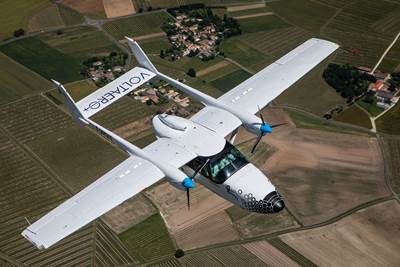VoltAero to build facility for hybrid-electric aircraft in France
Construction bids are now being sought after for the 7,400-square-meter factory, to hold three Cassio aircraft final assembly lines, along with a workshop, logistics area and offices.

Industrial facility rendering. Photo Credit: VoltAero
Bids are being sought for the construction of an industrial site at Rochefort – Charente-Maritime Airport in France’s Nouvelle-Aquitaine region where (Médis, France) is to perform the assembly and deliveries of its Cassio electric-hybrid aircraft family. VoltAero says its aircraft may use composites for some components like wings, canards, empennage and booms.
This construction project — issued by the regional association of airports, the Syndicat Mixte des Aéroports de La Rochelle – Ile de Ré et Rochefort – Charente-Maritime — will lead to the creation of a facility with three Cassio aircraft final assembly lines, along with a workshop, logistics area and offices.
Covering a total area of 7,400 square meters — with the possibility for future extensions — the building will initially provide 2,412 square meters of floor space. Project management is the responsibility of the Syndicat Mixte association, and the prime contractor role has been entrusted to the SDArchitectes agency (Rochefort, France).
The project’s cost of €4.4 million (excluding tax) includes road access to the site, as well as a tarmac area for the assembled Cassio aircraft, and a taxiway that connects to the Rochefort – Charente-Maritime Airport’s runway. The French government will contribute €665,000 as part of the National Fund for Territorial Planning and Development (FNADT). Discussions are underway with the Nouvelle-Aquitaine Region and the Agglomeration Community of Rochefort-Océan for their financial support of the project.
Advantages for the development of this aeronautical “industrial hub” will include:
- Quality of existing infrastructure, with a 2,280-meter-long × 45-meter-wide runway that accommodates medium-haul aircraft, along with three taxiways, a control tower, etc.;
- An overall available land surface of 16 hectares, with direct access to the runway;
- An absence of commercial air traffic, for the creation of activities that require frequent access to the runway and airport infrastructure;
- Road access, regional attractiveness and a central location on France’s Atlantic coast;
- A well-established aeronautical industry presence in the greater Rochefort region.
“VoltAero’s presence constitutes a go-ahead for the development of aeronautical industrial activities at the airport,” says Gérard Pons, president of the Syndicat Mixte des Aéroports de La Rochelle – Ile de Ré et Rochefort – Charente-Maritime. “I hope that this first facility will lead to test and development projects from other innovative aeronautical players.”
VoltAero is continuing the development of its Cassio hybrid-electric aircraft family, including the validation of the company’s proprietary electric-hybrid powertrain with flight tests of its Cassio 1 demonstrator — which has logged 135 flight hours while flying more than 10,000 kilometers.
VoltAero will offer three versions of the aircraft:
- Cassio 330, a five-seat configuration with propulsion from a combined hybrid-electric power of 330 kilowatts;
- Cassio 480, configured with six seats and a hybrid-electric propulsion power of 480 kilowatts;
- Cassio 600, with a 12-seat capacity and hybrid-electric propulsion power of 600 kilowatts.
Certification of Cassio is expected at the end of 2024, with the first aircraft expected to be delivered from VoltAero’s Rochefort – Charente-Maritime Airport facility in early 2025.
VoltAero currently employs 35 people. When the new facility is completed, the company will move its operations to Rochefort – Charente-Maritime Airport — which is targeted for June 2024 — with some 60 employees. When the planned production output is reached, the plant will employ 150 people and contribute to the creation of 450 indirect jobs.
Related Content
First Airbus A350 crash confirmed in Haneda
Shortly after touch-down, a JAL A350-900 aircraft recently collided with a De Havilland Canada Dash 8. Exact circumstances are still unknown.
Read MorePlant tour: Aernnova Composites, Toledo and Illescas, Spain
RTM and ATL/AFP high-rate production sites feature this composites and engineering leader’s continued push for excellence and innovation for future airframes.
Read MoreOtto Aviation launches Phantom 3500 business jet with all-composite airframe from Leonardo
Promising 60% less fuel burn and 90% less emissions using SAF, the super-laminar flow design with windowless fuselage will be built using RTM in Florida facility with certification slated for 2030.
Read MoreThe next-generation single-aisle: Implications for the composites industry
While the world continues to wait for new single-aisle program announcements from Airbus and Boeing, it’s clear composites will play a role in their fabrication. But in what ways, and what capacity?
Read MoreRead Next
VoltAero to cross English Channel with Cassio 1 demonstrator aircraft
The repeated electric aviation crossing emphasizes the Cassio program’s development phase advancements, as well as its anticipated 2023 certification.
Read MoreCeramic matrix composites: Faster, cheaper, higher temperature
New players proliferate, increasing CMC materials and manufacturing capacity, novel processes and automation to meet demand for higher part volumes and performance.
Read MoreCutting 100 pounds, certification time for the X-59 nose cone
Swift Engineering used HyperX software to remove 100 pounds from 38-foot graphite/epoxy cored nose cone for X-59 supersonic aircraft.
Read More












